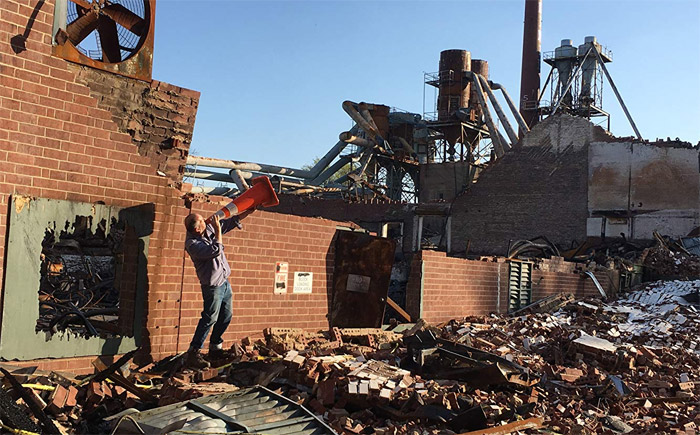Directed by Paul Duane
Picturehouse, Liverpool
25th September 2019
Reviewed by Ashley McGovern
We’re not averse to cultish feelings in Liverpool, especially when it comes to music. All the different tributaries of the Mersey sound are loyally worshipped. Nobody is too obscure to be without a following, a shining example of this being Bill Drummond.
Though Scottish Presbyterian by birth, the audience of Best Before Death/White Saviour Complex clearly deem him to be avant-garde Scouse. And on the night his post-punk pedigree looked like the main draw. A quick eavesdropping made clear that the crowd think of Drummond’s Zoo Records label and, much later, The KLF, as moments of exalted outsider art. Seated all around were people who could, no doubt, bore you with tales of Eric’s and their bootleg tapes of obscure 1970s indie groups; and next to these were some younger acid housers, eagerly waiting to be bored by stories of the period they just, by virtue of being at primary school, missed out on. All the same, it’s good they can conjure up the radical days of old, because Bill Drummond, the arch rebel, the self-saboteur’s self-saboteur, refuses point blank to talk about them.
In this documentary, directed by Paul Duane, people often ask about his life as a musician. Drummond is robustly evasive about his hijinks in the British music industry. On one occasion his driver, a resident of Lexington, Kentucky, asks if he knew anyone famous, and the sparse, typically awkward answer? Michael Jackson once walked into a recording studio where he was playing, and after he noticed he’d taken a wrong turn, walked straight out. That’s all we hear of his time at the antic fringes of pop.
Perhaps the reason is Drummond has a new project, a new world tour called ‘The 25 Paintings’ which is scheduled up until 2025, the year he expects he’s going to die.
His tour follows a series of simple instructions; he must travel around the world to engage and co-opt the natives into taking part in his performance art set pieces. Best Before Death focuses on two of the stops, both very different: the crowded Calcutta and the spacious, if downbeat part of Lexington. He has his set routine of tasks to rattle off.
In each place, he cooks soup, makes a bed from scratch, bakes cakes, shines shoes and plunges into the nearest local river. On the surface it’s an act of odd generosity, all of his tasks are eminently down-to-earth and designed to help whatever locals he meets. Not much is heard in terms of a grand theory. What art there is comes after the act of creation in the minds, conversations and uses of his gifts. It’s a kind of homely, earnest Situationism.
However, it’s not all quaint soup kitchen art; he often wants something in return. And if he can be accused, as he does to himself in the play that’s intercut with the movie, of having acute white saviorism then it’s a special, demanding case of it. Among his to-do list is to meet, quite accidentally, a local band and get them to play a freehand cover of one of his old pop songs – which in Calcutta allows us to see what how the noble sitar copes with rendering 1990s stadium pop. (Later on, during the live part, we hear a story about a man Drummond meets in Haiti, and following the terrible earthquake of 2010 asks for some financial support, something Drummond duly provides on the condition he files 1000 words of diaristic copy about his experience of the devastation).
As filmed, Drummond is a confident, often bafflingly eccentric, quietly death-obsessed, though never morbid, amiable and determined to see through this world tour, even if it’s artistic mission statement is muddled and perhaps will never be made clear, even on conclusion. I think his most affecting piece is the series of baptisms. Whilst in Calcutta he dons a new pair of jeans (telling us has exactly enough Levis to last to the end of his tour) and plunges into the Ganges. The documentary beautifully captures these spiritual moments. And you would think Duane’s human picture would satisfy any artist, even one who squirms at the thought of being captured, defined and exposed.
Not so with Drummond; hence why at Fact he steps forward with White Saviour Complex, an artistic right of reply. The short play takes the form of a one character two hander, performed by the artist and a Scottish actor who steps in to speak as him, in his very clothes.
This is the part where Drummond accepts there’s an accusation-in-waiting at the heart of Duane’s film: that of being a clueless, worse a pretentious, Western traveller who’s out to save a culture noticeably poorer than his own. This part, in must be said, wasn’t very successful.
As performance it consisted of awkward, unnecessary clothes-swapping and taking turns to read out from a play script that consisted of personal stories about helping out foreign men. The stories were far too rambling, but the main problem is that Drummond is a living breathing avant-gardist; he takes everything as the chance to make art, rather like Gilbert & George’s ‘Living Sculptures’. So humanitarianism, and the problems that come with it, is just another project, in the way breakfast and reading the gas metre are probably opportunities for Drummond to shape a disruptive happening.
The self-questioning in these stories wasn’t probing, revealing or condemnatory, if that’s what he now thinks of his tour – it added nothing to an otherwise brilliant documentary.

Permalink
I see the #metoo movement hasn’t reached the arty documentary directors yet.